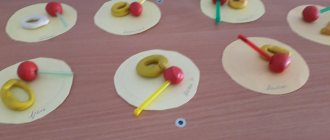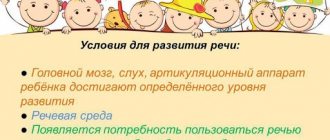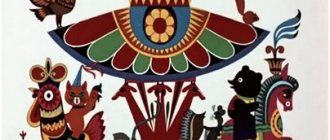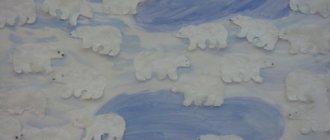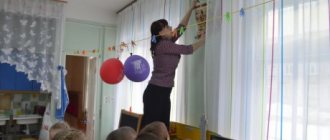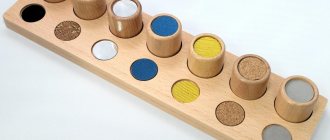Outline of a modeling lesson on the topic: “My Home” (preparatory group)
Productive activity “Modeling” Lesson plan on the topic: “My Home” in the preparatory group Goals: to develop children’s interest in modeling from plasticine;
To develop accuracy and perseverance in children. Objectives: to develop children’s understanding of home, city, native land; consolidate the ability to work in a stack, cut off excess parts of the columns, arrange parts of the building in a certain sequence; cultivate love and respect for your home and city; develop spatial imagination. Materials: stand templates cut out of cardboard (green, yellow), plasticine, stacks, boards for modeling, a ready-made sample of a plasticine house, napkins, a chest with demonstration material (pictures of the city, houses, wooden buildings). Work progress: V. Guys! Let's see what the magic chest has prepared for us today! (I take out photographs of recognizable “attractions” of my hometown) Q. What do you think is shown in the photograph? (children's answers) Absolutely right, these buildings - hospitals, pharmacies, cinemas, train stations - are located in our city. He will build a skyscraper and a stadium right on time. A kindergarten and a hospital, a line of shops. Even a house, I’ll tell you, Where my family lives, (I. Ilkh) V. And what else has our chest prepared for us, let’s see! (I take out pictures and photographs of residential buildings) V. All this was built by people, residents of our city, for you and me. Therefore, guys, we will also build a house for ourselves and our family. (I take out a finished sample of the product from the chest and an image of its step-by-step implementation) Q. For this you will need plasticine and your imagination! Productive activities under the guidance of a teacher. Tell the children that they need to roll a lot of columns, then make them the same length using a stack. Form a base on a template-stand in the form of a rectangle, place doors and windows on them, then assemble the walls of the house. At the same time, place the columns on top of each other. During the formation of the roof, you will also need columns, and each subsequent one should be smaller (a continuation of the wall is made on both sides in the form of a pyramid), after which the ridge is attached and the roof columns are attached to it. Near the house you can invite the children to make a bench or a tree. Outcome of the lesson: examination of buildings, discussion.
Attached files
univerfiles.com
“Modeling Birch and Christmas Trees”
Summary of educational activities in the middle group
on the topic: “Modeling birch and Christmas trees”
Target:
teach children to describe and compare trees and their benefits; convey in modeling the characteristic structural features of birch and spruce.
Tasks:
Learn to find characteristic features of the external structure of different types of trees; practice using plural nouns; learn to convey the thickness and location of Christmas tree and birch branches in sculpting; develop attention, logical thinking, curiosity, develop fine motor skills; develop the ability to use a stack; cultivate a love for native nature, a desire to learn more about the world around us.
Material:
plasticine white, green; pictures depicting trees of different types and trees of different heights and trunk thicknesses, boards for plasticine, half an A4 sheet for each child, napkins.
Progress of the lesson
Educator:
Guys, when I came to kindergarten, I found a letter. Dunno sent it to us: “Guys, I was walking in the park and saw many, many different trees there. I had fun, it was good to breathe fresh air, look at flying birds, squirrels jumping from branch to branch. I didn’t break branches from the trees, I treat trees with care, because they make the forest so fresh and good. I collected a lot of leaves from different trees, and then I looked at the collected bouquet and realized that I didn’t know which leaf was from which tree. Guys, please help me figure it out."
Educator:
Children, let's help Dunno figure out which tree is where (I show pictures of trees, and the children name them).
Educator:
And now, so that Dunno remembers the trees better, I will read the riddles, and you try to guess them.
I'm standing in the forest on one leg,
Cones on top, bears below,
Green in winter and summer,
The dress is covered in needles, but I call myself .. (Christmas tree).
Not caring about the weather, she walks around in a white sundress, and on one of the warm days May gives her earrings. (Birch)
I crawled out of the little barrel, put down roots and grew up, I became tall and powerful, I am not afraid of thunderstorms or clouds. I feed pigs and squirrels -
It’s okay that my fruit is small. (Oak)
Educator:
You know, children, if only birch trees grow in the forest, then this is a birch grove; if only oaks grow, then it is an oak forest; if only spruce trees grow, then this is a spruce forest; and if it’s pine, then it’s a pine forest.
Educator:
Children, what height are trees? (high, low).
What about thickness? (thick, thin).
What color are the Christmas tree needles?
Educator:
Well done. Do you know this tree?
Educator:
Yes, it's birch. White-trunked, curly, silky - these are the affectionate words used to call birch. Many poems and songs have been written about her. Birch produces tasty and healthy sap. You just have to collect it carefully so as not to damage the tree. In autumn, birch leaves turn yellow and fall off. The fruits of birch are catkins.
Summary of a lesson on modeling topic: Hometown (team work)
Uyimdastyrylgan oku іs - әreketіnіn technology maps Technological map of organized educational activities. Kunі/date: April kunnі/day of week: Top / Group: senior B Bilim take salas / Educational area: Creativity. Bolim / Section: MOLDING. Takyryby / Topic: Hometown. (teamwork) Maksaty / Goal: Teach children how to sculpt a house. Mindetteri / Objectives: developing the skills to create objects from plasticine. Learn to create objects from plasticine consisting of rectangular, square, triangular parts. To develop children's understanding that there are different houses in our city. Strengthen sculpting techniques (pulling, smoothing). Develop figurative ideas and imagination. Cultivate a positive attitude towards your hometown, feel pride in your city. Vocabulary work: Motherland. Equipment: Plasticine, boards, napkins, sample. Bilingual құрауш / Bilingual component: ––––– area Ә reket kezңderi Stages of activity Tarbieshіn әreketі / Actions of the teacher Balalardyn әreketі / Activities of children Esep/accounting + - Uazhdemelik – turtkіlik / Motivational-incentive K The word of joy: We put our hands in a row. It turned out to be a plane! We fly higher, higher. Higher than the house, higher than the roof, the pilot looks happier. Our plane has taken off! They recite the text together with the teacher. Uyimdastyrushylyk - izdenistik / Organizational - search Game moment: The teacher reads the poem: “What do we call Motherland? The land where you and I live.” There are a lot of big and small cities in the world. We live in the city of Pavlodar. In our city there are many one-story and multi-story houses. There are pharmacies, shops, cinemas, etc. What do we see when we walk around the city of Pavlodar? (shops, pharmacies, post office, homes). Poem: To build a new house, They stock up oak planks, Bricks, iron, paint. Nails, tow and putty. And then, then, then. They begin to build a house! Asks the children: - What is needed in order to build a house? Problem situation: Imagine that you are architects. Who knows who architects are? Use your imagination and come up with your own buildings. Where do you start? Examination of a sample: Let's look at the house, its parts: roof, windows, doors, their location. Demonstration of the modeling method: You have cardboard on the tables, you need to draw with a simple pencil the house you want. And then take plasticine of any color and decorate your home. To do this, you need to roll up a sausage from plasticine and attach it to the walls of the house, windows, doors, the “sausages” can be of different colors, then your houses will be bright and beautiful. Physics lesson: “Building a house” 1,2,3,4, they built a house from planks. Windows, doors were opened and they waved through the window! Individual work: During the lesson, monitor the children’s work, provide assistance with advice and instructions. Listen to a poem. Answer questions. Listen to a poem. They answer a problematic question. They look at the sample and name the parts of the house. Perform movements according to the text. Practical work. Reflective - corrective Analysis of children's work. After finishing the work, examine all the crafts, display them, and admire how many houses there are - several streets, a whole city. At the end of the lesson, pass a magic wand around the circle so that the children tell what they liked about the lesson. The teacher praises the children for their efforts. He reads the poem: Don’t look for it on the map among the capitals, Don’t look for it among the resorts and others. Ah, Pavlodar, my native city, You have become a small homeland for me. Ah, Pavlodar, my native city, I walk through life with you. You are my mentor, you are my teacher, I learn many of your lessons. Ah, Pavlodar, my native city, You became the beginning for me. Know that I am sad when I am not with you. They look at the work and share their impressions. Expected result: Know the parts of the house. Be able to sculpt thin flagella by rolling plasticine between your palms. Have – ideas about your homeland.
globuss24.ru
Summary of GCD for modeling in the middle group of preschool educational institutions
Summary of direct educational activities in artistic creativity (modeling) in the middle group
Topic: Houses of our city (Krasnoyarsk)
Goal: developing the ability to create objects from plasticine Tasks: Continue to teach using plasticine to create objects consisting of rectangular, square, triangular parts. To develop children's understanding that there are different houses in our city. Strengthen sculpting techniques (pulling, smoothing). Develop figurative ideas and imagination. Cultivate a positive attitude towards your hometown, feel pride in your city. Material: plasticine, modeling boards, stacks, cards depicting the Chapel and the Clock, paintings depicting houses in the city of Krasnoyarsk.
Progress of the lesson
Educator: What do we call the Motherland? (the place where we were born, live, go to kindergarten, where our mothers, fathers, friends live). “What do we call Motherland? The land where you and I live." Educator: There are a lot of big and small cities in the world. You and I live in the city of Krasnoyarsk. In our city there are many one-story and multi-story houses. There are pharmacies, shops, cinemas, etc. What do we see when we walk around the city of Krasnoyarsk? (shops, pharmacies, post office, houses) Educator: Let's clarify the appearance of the house, its parts: roof, windows, doors, their location. Imagine that you are architects. Who knows who architects are? Use your imagination and come up with your own buildings. Where do you start? Educator: you have cardboard on the tables, you need to draw with a simple pencil the house you want. And then take plasticine of any color and decorate your home. To do this, you need to roll up a sausage from plasticine and attach it to the walls of the house, windows, doors, the “sausages” can be of different colors, then your houses will be bright and beautiful. Educator : before we start work, we will divide into companies; there are cards on the tray. You need to choose one card and find a table on which there is a picture with the image of your card. (Cards: Chapel in the city of Krasnoyarsk, Tower clock on the Krasnoyarsk administration building). The children get to work . After finishing the work, look at all the crafts, display them, and admire how many houses there are - a whole city. Children talk about their craft. Praise for your efforts, feel proud of your favorite city. At the end of the lesson, pass a magic wand around the circle so that the children tell what they liked about the lesson.
We recommend watching:
Notes on educational activities in the middle group “Mushroom Glade” Notes on modeling from salt dough in the middle group of preschool educational institutions Notes on educational activities on modeling in the middle group. Tiger Summary of GCD on modeling for children of the middle group
Similar articles:
Lesson summary for the middle group: Safety at home
Summary of a lesson in kindergarten “Receiving guests.” Middle group
Lesson summary for the middle group on the topic: Properties of glass
Lesson in the middle group of kindergarten. Village courtyard
Summary of a lesson on cognitive development in the senior group. Rules of conduct in the circus
Summary of a modeling lesson in the preparatory group “Village Compound”
Summary of a modeling lesson in the preparatory group
Topic: “Village farmstead.”
Author: Chernova Tatyana Mikhailovna.
Target:
systematization and expansion of children's knowledge about domestic animals, their adaptability to their environment, and benefits to humans.
Tasks:
— clarify and expand children’s ideas about domestic animals, their appearance and lifestyle (behavioral characteristics, what they eat, what benefits they bring);
— teach children to understand the questions asked and answer them;
- continue to teach how to use speech as a means of communication;
- consolidate the ability to identify signs of similarity and difference between objects, to combine them into groups based on a common characteristic;
Materials for conducting organized educational activities:
— cards with images of pets, figurines of pets, cards for the game “Who eats what?”
Expected result:
As a result of joint educational activities, children will develop and expand their knowledge about domestic animals and their importance in human life.
Progress of OOD
1. Organizational moment
Children enter the group and stand in a circle.
- Guys, let's greet our guests. (greetings)
A box with a “surprise” appears in the group. The teacher gives the opportunity to guess what is in the box (children's answer options).
- the teacher asks a riddle:
He sits in a barn, in a cage. There are balls of fluff with him - children. He gnaws cabbage deftly, he also likes to gnaw carrots. He still looks like a bunny. Who is this? Guess it? ( Rabbit.)
2. Cognitive and research activities
- Guys, why do you think rabbits are not cold in winter? (children's answers, conclusion)
3.Fizminutka
Guys, do you want to play a little? (Yes) Then repeat after me.
— Guys, do you have a pet at home? How do you care for them? (Children's answers)
- Well done. Man needs all these animals and he cannot do without them. — How do we find out what you know about pets? And in what form can you show it to us? And our magic flower will tell us this. (play the quiz)
- Great! To conduct the quiz we will need a jury. (selected by the jury from those present). The jury will evaluate each team's correct answers.
— To play the quiz, we should divide into two teams.
Game "Whose child?"
(division into teams)
- Come to me and take an element of the picture. Collect the picture and go to the table on which there is a suitable figurine.
4. Quiz
(questions are given to each team in turn)
— First task for the teams: the game “Answer”
(riddles, using ICT)
He with a mustache, not a grandfather, catches a mouse for lunch. And the eyes are like emerald. Do you know what his name is? ( Cat
)
